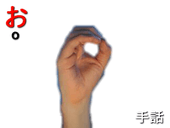O (kana)
In Japanese writing, the kana お (hiragana) and オ (katakana) occupy the fifth place, between え and か, in the modern Gojūon (五十音) system of collating kana. In the Iroha, they occupy the 27th, between の and く. In the table at right (ordered by columns, from right to left), お lies in the first column (あ行, "column A") and the fifth row (お段, "row O"). Both represent [o].
| Form | Rōmaji | Hiragana | Katakana |
|---|---|---|---|
| Normal a/i/u/e/o (あ行 a-gyō) |
o | お | オ |
| ou ō |
おう, おぅ おお, おぉ おー, お~ |
オウ, オゥ オオ, オォ オー, オ~ |
| o | ||||
|---|---|---|---|---|
| ||||
| transliteration | o | |||
| hiragana origin | 於 | |||
| katakana origin | 於 | |||
| spelling kana | 大阪のオ (Ōsaka no "o") | |||
| kana gojūon | ||||||||||||||||||||||||||||||||||||||||||||||||||
|---|---|---|---|---|---|---|---|---|---|---|---|---|---|---|---|---|---|---|---|---|---|---|---|---|---|---|---|---|---|---|---|---|---|---|---|---|---|---|---|---|---|---|---|---|---|---|---|---|---|---|
|
||||||||||||||||||||||||||||||||||||||||||||||||||
Derivation
お and オ originate, via man'yōgana, from the kanji 於.
Variant forms
Scaled-down versions of the kana (ぉ, ォ) are used to express morae foreign to the Japanese language, such as フォ (fo).
Stroke order
 Stroke order in writing お |
 Stroke order in writing オ |
The hiragana お is made with three strokes:
- A horizontal line from left to right.
- A stroke consisting of a vertical line, a small diagonal line going upwards and to the left, and an open curve heading right and downwards.
- A small curved stroke on the right.

The katakana オ is made with three strokes:
- At the top, a horizontal stroke from left to right.
- A downward vertical stroke cutting through the first stroke, with a small hook at the end facing left.
- At the intersection of the first two strokes, a diagonal line going downwards and to the left.
Other communicative representations
| Japanese radiotelephony alphabet | Wabun code |
| 大阪のオ Oosaka no "O" |
|
|
 |
 | |
| Japanese Navy Signal Flag | Japanese semaphore | Japanese manual syllabary (fingerspelling) | Braille dots-24 Japanese Braille |
- Full Braille representation
| お / オ in Japanese Braille | ||
|---|---|---|
| お / オ o | おう / オー ō/ou | +う / +ー chōon* |
* When lengthening "-o" syllables in Japanese braille, a chōon is always used, as in standard katakana usage instead of adding an お / オ.
| Preview | お | オ | オ | ㋔ | ||||
|---|---|---|---|---|---|---|---|---|
| Unicode name | HIRAGANA LETTER O | KATAKANA LETTER O | HALFWIDTH KATAKANA LETTER O | CIRCLED KATAKANA O | ||||
| Encodings | decimal | hex | decimal | hex | decimal | hex | decimal | hex |
| Unicode | 12362 | U+304A | 12458 | U+30AA | 65397 | U+FF75 | 13012 | U+32D4 |
| UTF-8 | 227 129 138 | E3 81 8A | 227 130 170 | E3 82 AA | 239 189 181 | EF BD B5 | 227 139 148 | E3 8B 94 |
| Numeric character reference | お | お | オ | オ | オ | オ | ㋔ | ㋔ |
| Shift JIS[1] | 130 168 | 82 A8 | 131 73 | 83 49 | 181 | B5 | ||
| EUC-JP[2] | 164 170 | A4 AA | 165 170 | A5 AA | 142 181 | 8E B5 | ||
| GB 18030[3] | 164 170 | A4 AA | 165 170 | A5 AA | 132 49 151 55 | 84 31 97 37 | 129 57 210 48 | 81 39 D2 30 |
| EUC-KR[4] / UHC[5] | 170 170 | AA AA | 171 170 | AB AA | ||||
| Big5 (non-ETEN kana)[6] | 198 174 | C6 AE | 199 66 | C7 42 | ||||
| Big5 (ETEN / HKSCS)[7] | 198 240 | C6 F0 | 199 166 | C7 A6 | ||||
| Preview | ぉ | ォ | ォ | |||
|---|---|---|---|---|---|---|
| Unicode name | HIRAGANA LETTER SMALL O | KATAKANA LETTER SMALL O | HALFWIDTH KATAKANA LETTER SMALL O | |||
| Encodings | decimal | hex | decimal | hex | decimal | hex |
| Unicode | 12361 | U+3049 | 12457 | U+30A9 | 65387 | U+FF6B |
| UTF-8 | 227 129 137 | E3 81 89 | 227 130 169 | E3 82 A9 | 239 189 171 | EF BD AB |
| Numeric character reference | ぉ | ぉ | ォ | ォ | ォ | ォ |
| Shift JIS[1] | 130 167 | 82 A7 | 131 72 | 83 48 | 171 | AB |
| EUC-JP[2] | 164 169 | A4 A9 | 165 169 | A5 A9 | 142 171 | 8E AB |
| GB 18030[3] | 164 169 | A4 A9 | 165 169 | A5 A9 | 132 49 150 55 | 84 31 96 37 |
| EUC-KR[4] / UHC[5] | 170 169 | AA A9 | 171 169 | AB A9 | ||
| Big5 (non-ETEN kana)[6] | 198 173 | C6 AD | 199 65 | C7 41 | ||
| Big5 (ETEN / HKSCS)[7] | 198 239 | C6 EF | 199 165 | C7 A5 | ||
| Look up お, ぉ, オ, or ォ in Wiktionary, the free dictionary. |
References
- Unicode Consortium (2015-12-02) [1994-03-08]. "Shift-JIS to Unicode".
- Unicode Consortium; IBM. "EUC-JP-2007". International Components for Unicode.
- Standardization Administration of China (SAC) (2005-11-18). GB 18030-2005: Information Technology—Chinese coded character set.
- Unicode Consortium; IBM. "IBM-970". International Components for Unicode.
- Steele, Shawn (2000). "cp949 to Unicode table". Microsoft / Unicode Consortium.
- Unicode Consortium (2015-12-02) [1994-02-11]. "BIG5 to Unicode table (complete)".
- van Kesteren, Anne. "big5". Encoding Standard. WHATWG.

